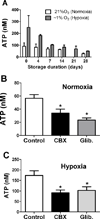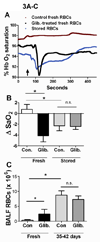Impaired adenosine-5'-triphosphate release from red blood cells promotes their adhesion to endothelial cells: a mechanism of hypoxemia after transfusion
- PMID: 21765360
- PMCID: PMC3196852
- DOI: 10.1097/CCM.0b013e318225754f
Impaired adenosine-5'-triphosphate release from red blood cells promotes their adhesion to endothelial cells: a mechanism of hypoxemia after transfusion
Abstract
Objective: Transfusion of red blood cells has been linked to disappointing clinical outcomes in the critically ill, but specific mechanisms of organ dysfunction after transfusion remain poorly understood. We tested the hypothesis that red blood cell storage impairs the ability of red blood cells to release adenosine-5'-triphosphate and that impaired adenosine-5'-triphosphate release was injurious in vivo, in part through increased red blood cell adhesion.
Design: Prospective, controlled, mechanistic study.
Setting: University research laboratory.
Subjects: Human and mouse blood donors; nude mouse transfusion recipients.
Interventions: Manipulation of adenosine-5'-triphosphate release, supplemental adenosine-5'-triphosphate, and antibodies to red blood cell and endothelial adhesion receptors were used in vitro and in vivo to probe the roles of released adenosine-5'-triphosphate and adhesion in responses to (transfused) red blood cells.
Measurements and main results: The ability of stored red blood cells to release adenosine-5'-triphosphate declined markedly within 14 days after collection despite relatively stable levels of adenosine-5'-triphosphate within the red blood cells. Inhibiting adenosine-5'-triphosphate release promoted the adhesion of stored red blood cells to endothelial cells in vitro and red blood cell sequestration in the lungs of transfused mice in vivo. Unlike transfusion of fresh human red blood cells, stored red blood cell transfusion in mice decreased blood oxygenation and increased extravasation of red blood cells into the lung's alveolar air spaces. Similar findings were seen with transfusion of fresh red blood cells treated with the adenosine-5'-triphosphate release inhibitors glibenclamide and carbenoxolone. These findings were prevented by either coinfusion of an adenosine-5'-triphosphate analog or pretransfusion incubation of the red blood cells with an antibody against the erythrocyte adhesion receptor Landsteiner-Wiener (intercellular adhesion molecule-4).
Conclusions: The normal flow of red blood cells in pulmonary microvessels depends in part on the release of antiadhesive adenosine-5'-triphosphate from red blood cells, and storage-induced deficiency in adenosine-5'-triphosphate release from transfused red blood cells may promote or exacerbate microvascular pathophysiology in the lung, in part through increased red blood cell adhesion.
Conflict of interest statement
Figures







Comment in
-
Losing control over adenosine 5'-triphosphate release: implications for the red blood cell storage lesion.Crit Care Med. 2011 Nov;39(11):2573-4. doi: 10.1097/CCM.0b013e31822a55fa. Crit Care Med. 2011. PMID: 22005234 Free PMC article. No abstract available.
Similar articles
-
Losing control over adenosine 5'-triphosphate release: implications for the red blood cell storage lesion.Crit Care Med. 2011 Nov;39(11):2573-4. doi: 10.1097/CCM.0b013e31822a55fa. Crit Care Med. 2011. PMID: 22005234 Free PMC article. No abstract available.
-
Restoration of intracellular ATP production in banked red blood cells improves inducible ATP export and suppresses RBC-endothelial adhesion.Am J Physiol Heart Circ Physiol. 2014 Dec 15;307(12):H1737-44. doi: 10.1152/ajpheart.00542.2014. Epub 2014 Oct 10. Am J Physiol Heart Circ Physiol. 2014. PMID: 25305182 Free PMC article.
-
Does the storage time of transfused red blood cells influence regional or global indexes of tissue oxygenation in anemic critically ill patients?Crit Care Med. 2004 Feb;32(2):364-71. doi: 10.1097/01.CCM.0000108878.23703.E0. Crit Care Med. 2004. PMID: 14758149 Clinical Trial.
-
Purinergic control of red blood cell metabolism: novel strategies to improve red cell storage quality.Blood Transfus. 2017 Oct;15(6):535-542. doi: 10.2450/2017.0366-16. Epub 2017 Apr 12. Blood Transfus. 2017. PMID: 28488967 Free PMC article. Review.
-
Role of storage time of red blood cells on microcirculation and tissue oxygenation in critically ill patients.Curr Opin Anaesthesiol. 2009 Apr;22(2):275-80. doi: 10.1097/ACO.0b013e328323f7c4. Curr Opin Anaesthesiol. 2009. PMID: 19390254 Review.
Cited by
-
Impaired skeletal muscle blood flow control with advancing age in humans: attenuated ATP release and local vasodilation during erythrocyte deoxygenation.Circ Res. 2012 Jul 6;111(2):220-30. doi: 10.1161/CIRCRESAHA.112.269571. Epub 2012 May 29. Circ Res. 2012. PMID: 22647875 Free PMC article.
-
Red blood cell phenotype fidelity following glycerol cryopreservation optimized for research purposes.PLoS One. 2018 Dec 21;13(12):e0209201. doi: 10.1371/journal.pone.0209201. eCollection 2018. PLoS One. 2018. PMID: 30576340 Free PMC article.
-
Losing control over adenosine 5'-triphosphate release: implications for the red blood cell storage lesion.Crit Care Med. 2011 Nov;39(11):2573-4. doi: 10.1097/CCM.0b013e31822a55fa. Crit Care Med. 2011. PMID: 22005234 Free PMC article. No abstract available.
-
Erythrocyte storage increases rates of NO and nitrite scavenging: implications for transfusion-related toxicity.Biochem J. 2012 Sep 15;446(3):499-508. doi: 10.1042/BJ20120675. Biochem J. 2012. PMID: 22720637 Free PMC article.
-
Vesicular and conductive mechanisms of nucleotide release.Purinergic Signal. 2012 Sep;8(3):359-73. doi: 10.1007/s11302-012-9304-9. Epub 2012 Apr 12. Purinergic Signal. 2012. PMID: 22528679 Free PMC article. Review.
References
-
- Lacroix J, Hebert PC, Hutchison JS, et al. Transfusion strategies for patients in pediatric intensive care units. N Engl J Med. 2007;356:1609–1619. - PubMed
-
- Hebert PC, Wells G, Blajchman MA, et al. A multicenter, randomized, controlled clinical trial of transfusion requirements in critical care. Transfusion Requirements in Critical Care Investigators, Canadian Critical Care Trials Group. N Engl J Med. 1999;340:409–417. - PubMed
-
- Koch CG, Li L, Sessler DI, et al. Duration of red-cell storage and complications after cardiac surgery. N Engl J Med. 2008;358:1229–1239. - PubMed
-
- Rao SV, Jollis JG, Harrington RA, et al. Relationship of blood transfusion and clinical outcomes in patients with acute coronary syndromes. JAMA. 2004;292:1555–1562. - PubMed
-
- Tinmouth A, Fergusson D, Yee IC, et al. Clinical consequences of red cell storage in the critically ill. Transfusion. 2006;46:2014–2027. - PubMed
Publication types
MeSH terms
Substances
Grants and funding
LinkOut - more resources
Full Text Sources
Other Literature Sources
Medical

